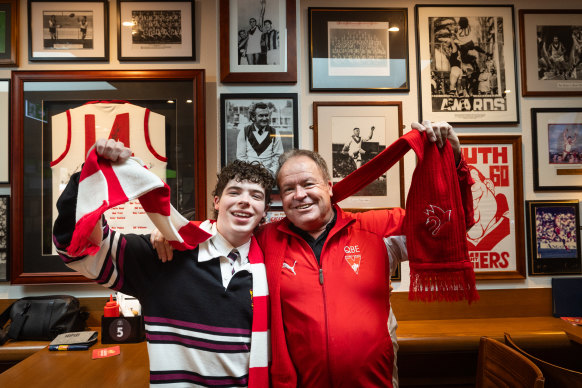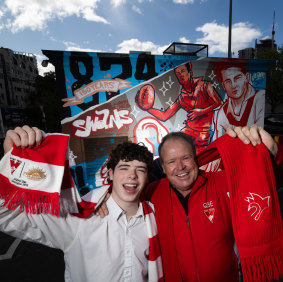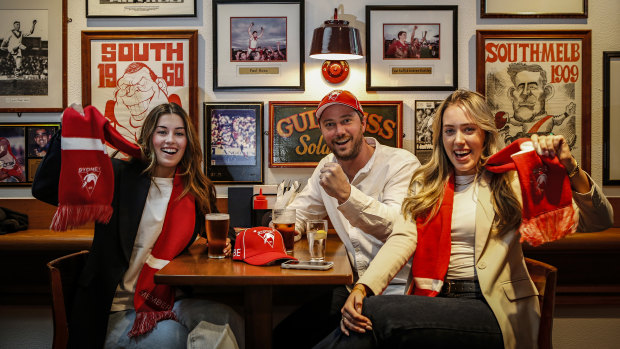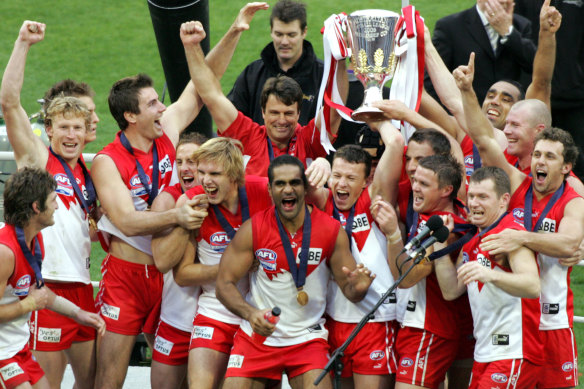By Greg Baum
Three days before the 2006 grand final, Rob Pascoe’s wife, Fiona, was induced so that he could be at the MCG to watch his beloved Sydney Swans in the big one. On the day, she joined him at half-time, taking a taxi from Sofitel where she was resting up and leaving newborn Charlie with a midwife.
One dramatic element of that week centred on Swans ruckman Darren Jolly and whether he would play if his wife went into labour. “And I’m thinking, I’m just a supporter, and we’re going to be there,” Pascoe said this week.

Rob Pascoe with son Charlie at the Rising Sun in South Melbourne.Credit: Jason South
Pascoe was on the Sydney board for 15 years and his sustainability company, Closed Loop, has an office there, but he has never lived in his club’s namesake city. He is one of about 10,000 Swans members who keep the South Melbourne flame alive and bright in Melbourne more than 40 years after their epochal move north.
Their hub is the Rising Sun hotel in Raglan Street, within the gravitational pull of the Swans’ former Lakeside Oval home ground. Under the newish management of Jon and Annalise Woolley, it is both a veritable red-and-white museum and a social centre, hosting packed functions to coincide with every Swans game, wherever it is played.
“The finals are a different level,” said Jon Woolley. “Last week, it just went off.” For Friday night, every nook and cranny is booked out. Woolley, incidentally, has run other popular pubs in the South Melbourne hinterland – but barracks for Carlton.
South Melbourne is still Swans country. Not much more than an Isaac Heeney roost away from the Rising Sun, in a corner of the famous South Melbourne market, is a Swans mural, a joint project of the club and Port Phillip Council, painted by Indigenous artist Jesse Wright, who in a neat twist is an emigre from Sydney to Melbourne.
The mural was unveiled four months ago as part of the Swans’ 150th celebrations. A line of throwback merchandise has been selling briskly, according to Swans Melbourne manager Jonathon Monasso, and the club’s annual family day at Marvel Stadium, coinciding with their last game in Melbourne, drew twice as many as usual. There’s nothing like a good year to make a good year.
The Brisbane Lions, nee Fitzroy, also have about 10,000 members in Melbourne, but the consensus is that the Swans generally draw more people to their Melbourne games, which are lamentably few for both clubs.

Rob and Charlie Pascoe at the Swans mural at South Melbourne market.Credit: Jason South
“The fundamental difference was that Fitzroy merged,” said Pascoe. “We were still the same club, same colours, same song – now – and we were still going to be in Melbourne every second week, and we could watch the team every other week live on TV. I think that helped people get over it quicker than it did them.”
But it hasn’t all been red and white and rosy. Pascoe inherited his ardour for South Melbourne from his mother, whose father once tried out for the Swans’ reserves. He has early, blissful memories of climbing under the fence at the Lakeside Oval with cousins who lived in Albert Park to watch the Swans play.
In 1970, when he was eight, his family rushed back from a holiday in Queensland because Peter Bedford had won the Brownlow Medal and South had made the finals for the first time in 25 years. They lost, and would wait another 25 years to win a final.
Pascoe was at university in 1982 when the Swans moved to Sydney, fore-running the national competition, but splitting the club and its fans. “It got very ugly,” he said. “We had two coaches, two captains, two committees.” A cheesy new theme song, Up There for Sydney, jarred. He knows erstwhile fans who threw in their lot with Port Melbourne down the road instead.

South Melbourne’s Peter Bedford, who won the Brownlow Medal in 1970.Credit: Fairfax Media.
His own fervour dulled. But there was an upside. “We could watch them on television,” he said. “Being the first club that you watch live every Sunday in the early ’80s, it created a lot of interest.” The Swans gained fans interstate and became a favourite “second team”.
But in Pascoe’s recall, Sydney held South Melbourne at arm’s length until early this century. By then successful in business, he became a sponsor and helped to set up two coteries. Roosie’s Red And Whites was like Collingwood’s Woodsmen, for the well-heeled. “We knew there was a lot of support, a lot of passion in Melbourne – and also a lot of money,” he said. “We were missing an opportunity.”
The Blood Brothers was to lobby for a Melbourne rep on the Sydney board. Duly, he was it. “It was to keep the tradition alive, and the culture,” he said. “It wasn’t until then that we were recognised by the club in Sydney for our long heritage. We weren’t a club that had been in existence for 25 years – it was 125 years.”
The Swans had SMFC sewn into the collars of their guernseys, reverted to their old and stirring Cheer Cheer anthem and set up a new and larger office in Melbourne run by former player Tony Morwood, who reached out to past players and drove new memberships. More recently, they have begun to wear the old South Melbourne guernsey in Melbourne games.

Swans fans Sophie Morris, Zac Chapman and Chelsea Schultz enjoy a drink at the Rising Sun ahead of their side’s preliminary final clash with Port Adelaide.Credit: Paul Rovere
The 2005 premiership clinched the club’s new contract with South Melbourne; you could say it was sealed in Bloods. “It was a time when the club finally healed old wounds,” Pascoe said. “Those wounds ran pretty deep.” That day to this, they’ve been too good a first team to be anyone’s second team, winning another flag and playing in three other grand finals.
“The excitement for me is that we now have a third generation of kids whose parents never saw South Melbourne play in Melbourne,” Pascoe said. “Much more these days than then, it’s a national competition. I don’t think it really matters where you play. We’ve been so fortunate with our club to have such strongholds in the two biggest cities.”

Sydney Swans celebrate after winning the grand final.Credit: Wayne Taylor
Pascoe stayed on the board until replaced by 2005 hero Leo Barry in 2020. This year, he was made a life member of the Swans alongside former coach Rodney Eade and longtime recruiter Kinnear Beatson.
Pascoe’s office is just around the corner from the Rising Sun. He was there with dozens of others for lunch on Thursday, basking in the red-and-white aura.
“I watched the first final there, and I’ve got to say I’d prefer to be at the ‘Riser’ [his nickname] than at the game,” he said. “It’s like you’re at the game, but there’s no opposition.”
But as the Swans take on Port Adelaide in the first preliminary final on Friday night, he will be at the SCG. Alongside him will be Charlie, the ultimate but unwitting team player from 2006, who is about to turn 18.
Keep up to date with the best AFL coverage in the country. Sign up for the Real Footy newsletter.